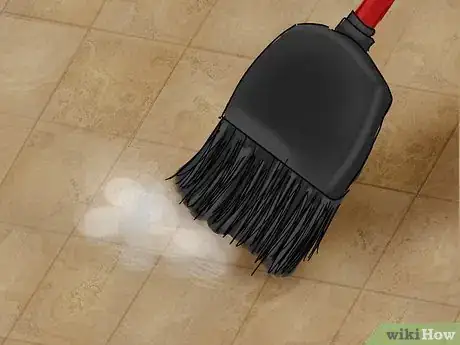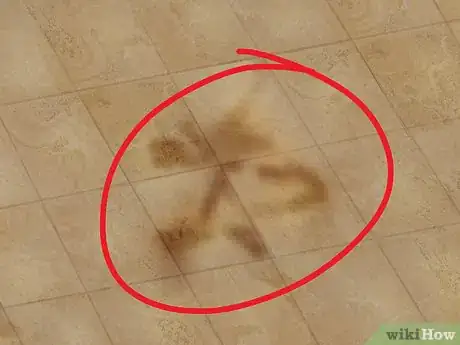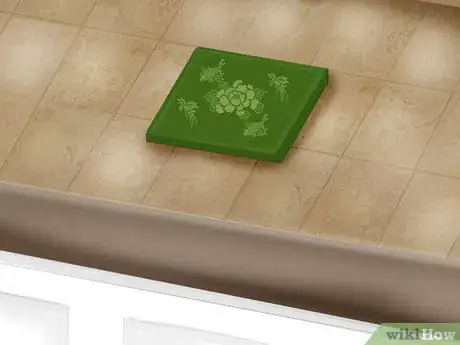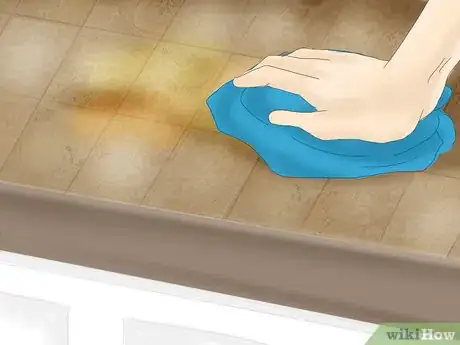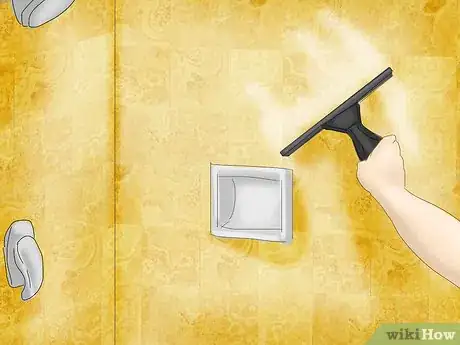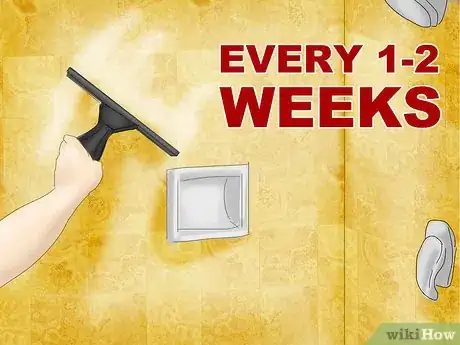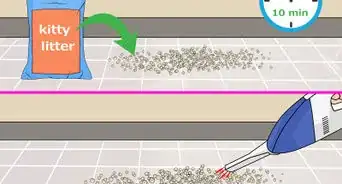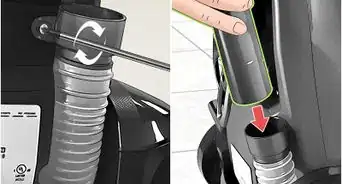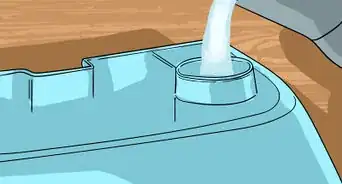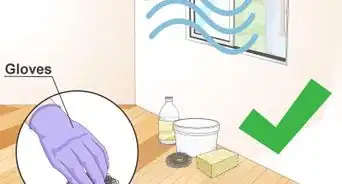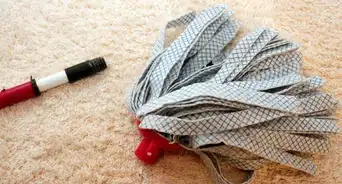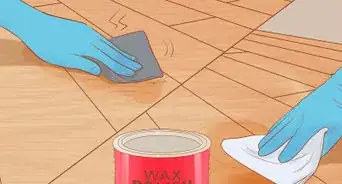This article was co-authored by Brandon Beckwith. Brandon Beckwith is a House Cleaning Specialist and the CEO of Reliable Housekeeping in Sacramento, California. Brandon and his team specialize in house cleaning such as maintenance cleaning, deep cleaning, move in/out cleaning, apartment cleaning, as well as commercial cleaning, window cleaning, and carpet cleaning. All members of the Reliable Housekeeping team receive background checks and professional training. Their family-owned and operated business is licensed, insured, and bonded.
This article has been viewed 186,580 times.
Travertine stone is a popular choice for floors, countertops, and showers. It its not as hard or dense as granite. Like many stone products, travertine can be etched and stained from acidic liquids, such as coffee and juice, and harsh cleaners. While sealing helps guard against etching and staining, knowing how to protect and clean your travertine floors, countertops, and showers will ensures that they remain in pristine condition.
Steps
Cleaning Travertine Floors
-
1Protect your floors. The high traffic areas of your home with travertine floors, such as a doorway or a hallway, are more susceptible to damage. In order to keep your floors pristine, it is necessary to provide additional protection to high traffic areas. Protect these areas from abrasive dirt and damaging grime with seasonal doormats, sleek runners, and timeless area rugs.[1]
-
2Dry clean your floors. Travertine floors are easily damaged and must be cleaned with care. To maintain a well-kept floor, vacuum, dust, and sweep your travertine regularly.
- Never drag an upright or full sized canister vacuum across your floor to suck up debris. Instead, suck up abrasive debris that might scrape your floors, such as dirt and gravel, with a handheld vacuum.
- Remove dirt and debris from your floors with a dry dust mop.
Advertisement -
3Wash your floors. When washing your floors, only use a soapless, neutral PH 7 mild abrasive cleaner and water. Always follow the product’s instructions. Use broad sweeping motions that overlap to clean your floor. Dry and polish with a clean microfiber cloth.
- To deep clean your floors, you may use an automatic scrubber with disk brush attachment.
-
4Remove stains from your travertine floors. As a porous stone, travertine stains easily. After identifying what caused the stain, use specific products to remove the blemish.
- Oil-based stains darken the stone and must be removed with chemicals. Blot the stain with a clean cloth to remove any excess residue. To remove the stain, use a soft liquid household cleaner, such as ammonia, acetone, or detergent. Apply the product to the stone on a damp cloth. Place the cloth over the stain to draw out the oil-based product.
- Organic stains, such as those caused by coffee, juice, urine, and food, turn the travertine pink or brown. Remove these stains with a mixture of 12% hydrogen peroxide—food grade hydrogen peroxide—and a few drops of ammonia.[2] Apply the product to the stone on a damp cloth. Place the cloth over the stain to draw out the organic stain.
- The method for removing ink stains varies based on the color of the stone. If the stain is on a light colored stone, use bleach or hydrogen peroxide; if the stain is on a dark colored stone, it is best to use acetone or lacquer thinner. Apply the product to the stone on a damp cloth. Place the cloth over the stain to draw out the ink stain.
- To remove water stains, buff the blemish with #0000 steel wool.
- Before you can remove etch marks, you must thoroughly remove the acid that caused them. Once the acid is removed, wet the surface and use a buffing pad to apply marble polishing powder. Buff and polish until the marks are gone.
-
5Use water to clean outdoor travertine. Clean travertine installed outdoors at least once per year. Rinse the stone with water to remove excess dirt and debris. To clean travertine that is not regularly maintained, use a pressurized water hose to remove caked on dirt.
Cleaning Travertine Countertops
-
1Protect your travertine countertops. Acidic liquids, hot pans, and wet glasses can damage your travertine countertops. The best way to combat damage is to prevent it. Use hot pads, placemats, and coasters on your kitchen countertops. In your bathroom, place all of your beauty and health products on a vanity tray instead of directly on the counter.
-
2Clean up spills immediately. Travertine is a porous stone that absorbs liquids. When accidents happen, blot up the spill right away. Wiping up the spill will only cause the item to spread, increasing the area susceptible to a permanent stain.
- Once a year, seal your countertops. This layer of protection will prevent stains from setting.
-
3Clean regularly with gentle products. Sanitize and wipe down your travertine countertops on a regular basis with hot water, gentle cleaners, and a microfiber rag.
- Spray the surface with a gentle cleaner that is safe on natural stone. Don’t use chemicals that are not designed to clean stone: they can damage the sealant and even leave permanent stains.
- Wipe up the cleaner with a fresh microfiber rag.
- Polish the surface with a new microfiber cloth.[3]
Cleaning Travertine Showers
-
1Squeegee and wipe down your shower after every use. Following a shower, your shower’s walls are covered in water, soap, and dirt particles. When left on the walls, soap scum is formed and mildew and molds grow. To prevent the build up of these items, squeegee your shower walls and door after each use. Run over the walls and corners with a clean, dry towel to soak up any remaining water. Leave the shower door ajar to allow the area to dry.
- Maintaining this daily routine will make it easier to clean your travertine shower.
- To eliminate soap scum, switch from bar soap to liquid soap.
-
2Clean your shower every one to two weeks. While wiping down your shower walls after each use will dramatically decrease the presence of soap scum, mildew, and mold, trace amounts of these items will cover your shower walls. Clean your shower every one to two weeks.
- Spray the walls and shower door with a gentle cleaner.
- Allow the product to sit for 5 to 10 minutes.
- Buff the travertine stone, glass, and metal fixtures with a clean microfiber cloth.
- Eradicate mineral build-up with a stone scrub, an abrasive cleaner that should be used with caution on polished surfaces. Spray the treated area with a gentle cleaner and blot with a microfiber cloth.
-
3Deep clean and assess the integrity of your travertine twice a year. Constant exposure to water can damage travertine tiles, ruin grout, and encourage the production of soap scum, mildew, and mold. To maintain a clean, structurally sound shower, conduct a deep clean and an assessment every six months.
- Treat your walls with a soap film remover to remove soap scum build up. Allow the product to sit for a few minutes before polishing it off with a microfiber rag.
- Target mildew and mold in your shower with a mild mildew remover. After allowing product to sit for a few minutes, remove the residue with a clean microfiber rag.
- Examine your grout and search for cracks and holes. If you discover any missing grout, repair it immediately—cracks and holes in the grout may lead to extensive water damage. Allow the repaired grout to cure for 7 to 10 days.
- Observe the tiles for discoloration. If you spot a dark tile that was once light, this is a sign of water absorption. Apply a sealer to your shower.
Community Q&A
-
QuestionCan I use a small amount of bleach to remove mold in shower seams?
 Community AnswerYes! About an hour or so before you plan to take your shower, just spray some bleach where you have mold. Then while you're taking your shower, just rinse off the bleach.
Community AnswerYes! About an hour or so before you plan to take your shower, just spray some bleach where you have mold. Then while you're taking your shower, just rinse off the bleach. -
QuestionHow do I remove scratches from travertine counter tops?
 Community AnswerSoak a piece of soft cloth in mineral oil (olive oil or linseed oil) and gently rub the scratch on the limestone. Watch the mineral oil penetrate the stone and make the scratch disappear within just a few seconds. Use a stone sealer to eliminate minor scratches.
Community AnswerSoak a piece of soft cloth in mineral oil (olive oil or linseed oil) and gently rub the scratch on the limestone. Watch the mineral oil penetrate the stone and make the scratch disappear within just a few seconds. Use a stone sealer to eliminate minor scratches.
Warnings
- Avoid placing makeup, hair and nail products, perfumes and other toiletries directly on travertine tiles. Use a tray or towel beneath these items to keep the surface clean, dry and free of acids.⧼thumbs_response⧽

